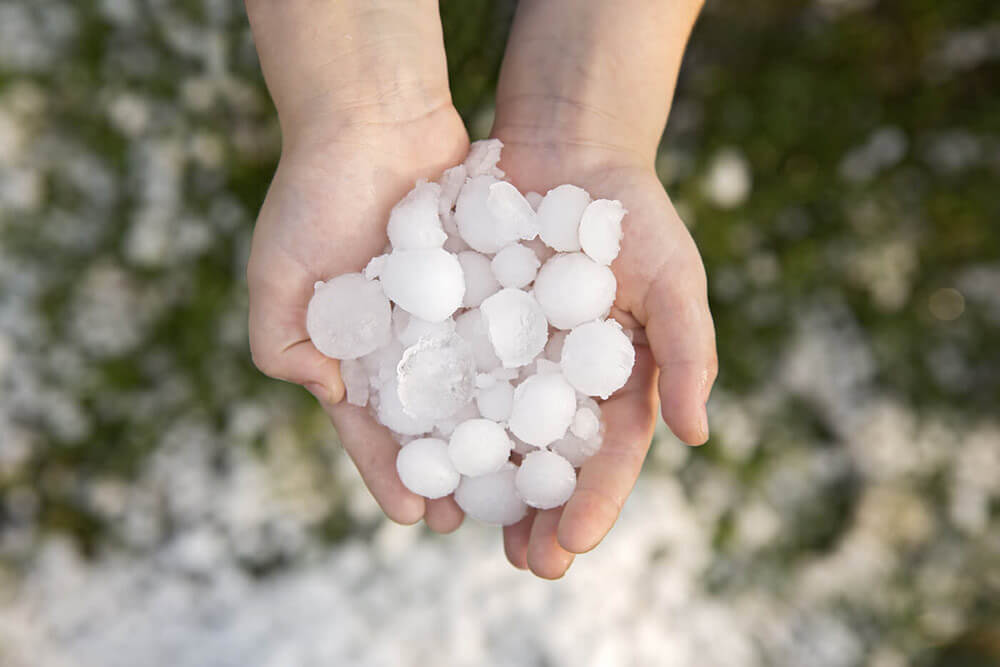Summer is the best time of year for camping, cottaging and backyard barbecues. It’s also the worst time of year for hail – especially if you live in Alberta or another Prairie province, which are prone to (sometimes severe) hailstorms between June and September. In fact, 51% of all storm-related damage in Canada since 2010 has occurred in Alberta, costing home and car owners around five billion dollars! Here are a few things we think you should know about hail, plus a to-do list to help you protect your home against hail before and after a hailstorm. (Don’t worry, we’ve got your car covered in
What is hail, anyway?
In a nutshell, hail is precipitation that turns into pellets of ice, usually around the size of a pea or a marble – though in some cases, hail stones have been larger than golf balls. You can probably imagine how much damage can be caused when you have a bunch of marbles or golf balls raining down from the sky! No matter how big or small it is, hail can cause significant damage to your home.
What kind of damage can hail cause to my home?
Hail of any shape and size can cause some serious damage to your roof, creating holes and dents, which then lead to leaks and water damage inside your home. It can destroy unprotected windows, damage any appliances you might have outside (like an air conditioning unit) or put some serious dings in your aluminum siding. And, it can tear up that gorgeous garden you’ve spent months coaxing and nurturing.
Does home insurance cover hail damage?
In Canada, most providers offer hail coverage. It typically covers broken windows and damage to your roof and siding. But if you’re a homeowner or own a rental property in Alberta, you may need to purchase separate hail coverage. On the other hand, if you’re a renter or a condo owner in Alberta it’s already included in your policy. Heads up! At Sonnet, hail coverage isn’t automatically included when you buy an Alberta home or landlord insurance policy.
The bottom line? When you’re buying new insurance, always check if hail coverage is included. Unsure if your current insurance has hail coverage? Carefully review your policy wordings and contact your insurer so you can take the proper steps to ensure you’re fully protected.
Keep in mind that some policies do have conditions that apply – like if your roof is past a certain age,
Hail can also cause other secondary problems for your home – like
How can I protect my home from hail?
Here’s what you can do to minimize hail damage to your home, and the steps to take after a storm hits:
Before it hails:
-
- Sign up for weather alerts on your phone, so you’re always kept up to date on when severe weather is coming.
- Have your roof inspected (by a professional, don’t try to do it yourself) and take care of any repairs.
- Consider investing in hail-resistant roofing and siding.
- Get protective film to cover your windows. This helps to prevent window glass from shattering.
- Take care of any potential hazards around your home – trim trees to remove branches that could fall on your home and clear eavestroughs, storm drains and downspouts to prevent ice dams.
- Don’t forget to move things like lawn furniture or your barbecue to sheltered areas when you’ve been alerted to an imminent hailstorm. Cover your garden, too, if possible.
- Once you’re safe indoors, close all drapes or window shades to prevent broken glass from flying across the room.
After it hails:
-
- Be sure to wait until the storm has completely passed before you head outside to check for hail damage.
- Check your windows and skylights for any chips, cracked glass or broken seals.
- Check your gutters for dents (Fun fact: Professionals call these dents “innies” and “outies!”)
- Take photos or video of any damaged property if you plan to make an insurance claim.
- Have a professional roof inspector check your roof and the rest of your home for any damage. Take care of any repairs right away.
- Keep receipts for any cleanup or repair costs.
As with any extreme weather event (like
